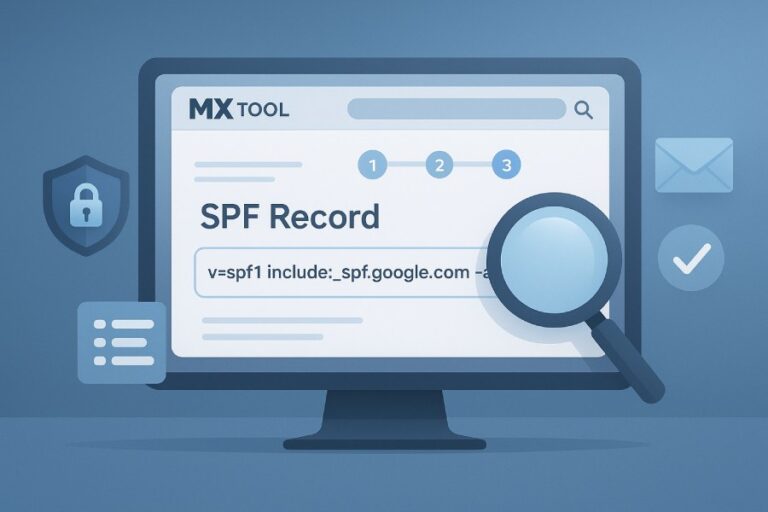The Sender Policy Framework (SPF) has emerged as an indispensable component of modern email authentication, safeguarding domains from rampant abuse and helping organizations maintain their reputation in a global digital landscape threatened by increasingly sophisticated threats. As defined in RFC 7208, the SPF standard—maintained by the Internet Engineering Task Force (IETF)—enables domain owners to designate authorized sending hosts and IP addresses via DNS records, thus curtailing impersonation, phishing, and spam.
Below, we analyze twelve core reasons why implementing the SPF standard is non-negotiable for any domain owner, with focused insights on the first four: preventing email spoofing, enhancing reputation, reducing phishing risks, and improving deliverability.
1. Prevents Email Spoofing and Impersonation
The Core Function: Authenticating the Envelope From
Email spoofing is a pervasive threat where malicious actors forge the sender address, making fraudulent emails appear to originate from legitimate domains. This practice exploits vulnerabilities in the Simple Mail Transfer Protocol (SMTP), particularly during the handshake process where the envelope from and Return-Path headers are introduced. The SPF standard directly addresses this by allowing domain owners to publish TXT records in DNS that specify which IP addresses and servers are permitted to send emails on their behalf.
Under the SPF verification process, when a receiving mail server receives a message, it initiates a DNS query for the SPF record of the sending domain name. The record, typically published with the v=spf1 SPF version identifier, enumerates all authorized sending hosts and mechanisms—such as ip4, A record, and MX—that are allowed to relay messages from that domain’s envelope from address.
Mechanisms Against Impersonation
If an unauthorized server attempts to send a message using your domain, the receiving mail transfer agent performs an SPF check. Should the sender’s IP not match those listed in the published SPF record, the system can return an SPF FAIL result, triggering enforcement actions such as spam filtering, allow list removal, denylist addition, or outright rejection. The use of policies like SPF FAIL policy, softfail policy (SOFTFAIL), or even experimental RFC options ensures that spoofed emails are appropriately identified and managed based on the domain owner’s policy publishing preferences.
Tied to Open Standards and Best Practices
The evolution of SPF as a proposed standard—initiated by key figures such as Paul Vixie, Dana Valerie Reese, and Meng Weng Wong within the MARID working group and ASRG—ensured its focus on genuine, sender-authenticated communication. Unlike proprietary SPF alternatives or controversial approaches like Microsoft’s CallerID and Sender ID, SPF’s IETF-backed model, as later codified in RFC 7208, directly fortifies the chain of trust by securing the Return-Path, envelope from, and sender header, while remaining agnostic to changes in header-from or remailer behavior.

Why This Matters
By formally identifying which mail servers can send on behalf of your domain using specific SPF mechanisms and syntax, you close a common loophole exploited by phishers and spammers, significantly mitigating the risk of reputation loss, user mistrust, and legal liability tied to impersonation attempts.
2. Enhances Your Domain’s Email Reputation
The Role of Reputation Systems and Compliance
In today’s interconnected email ecosystem, reputation systems—which often leverage DNS-based blackhole lists (DNSBL), SPF PASS and FAIL results, and DMARC alignment—evaluate the trustworthiness of sending domains. Without a proper SPF implementation and policy, your domain could be flagged by major service providers’ spam filters or even end up on a denylist, limiting your ability to reach intended recipients.
SPF compliance signals to ISPs and message transfer agents that your organization takes email authentication seriously. By rigorously defining SPF policies within the DNS records of your domain name and keeping them up to date, you facilitate a chain of trust among global mail servers, reducing the risk that emails containing your identity will be used for email spam or malicious activity.
The Process: From DNS Query to SPF Result
When a receiving client or server analyzes an incoming message, it retrieves the SPF type 99 (or, more commonly, the TXT record per SPF RR type best practices) and processes the included mechanisms. A properly handled SPF check results in either an SPF PASS result (message accepted), SPF SOFTFAIL or neutral (message potentially filtered), or SPF FAIL result (message rejected or tagged). This detailed SPF result allows reputation systems and email filters to fine-tune handling, while Return-Path headers and the associated HELO identity are used to further validate the sender’s legitimacy.
Benefits for Ongoing Communication
As more organizations and servers enforce SPF verification and related authentication methods such as DMARC—which nests SPF and DKIM as underlying protocols—the association between your domain policy, SPF record, and email reputation grows ever stronger. Should you wish to ensure uninterrupted newsletter delivery, critical notifications, or business communications, the SPF standard is a cornerstone for maintaining whitelisting status and remaining on recipient allow lists.
3. Reduces the Risk of Phishing Attacks
Targeting Phishing at Its Source
Phishing remains one of the most damaging vectors for cybercrime, often relying on forged email addresses and domain names to trick unsuspecting users into divulging sensitive information or installing malware. Without SPF checks in place, fraudsters can easily spoof your domain in the envelope from or Return-Path header, lending a false air of legitimacy to their messages.
Mitigating Phishing via DNS Records and Policy Enforcement
By publishing an explicit SPF record—crafted with accurate SPF syntax and up-to-date lists of authorized sending hosts and mechanisms (such as MX, ip4, PTR record, and A record)—domain owners can block fraudulent emails at the SMTP gateway. The recipient’s mail server will perform an SPF verification, consulting DNS records to match the originating IP address against the domain’s allow list of designated mailers. If the check fails to yield a SPF PASS result, and instead returns a FAIL or SOFTFAIL, the message is flagged, sent to spam folders, or outright rejected, thus protecting end-users from phishing attempts.

Harmony with DMARC and Modern Defenses
The SPF standard works in tandem with DMARC (Domain-based Message Authentication, Reporting, and Conformance), an advanced email authentication framework that enables domain owners to publish domain policy instructions for dealing with failed SPF and DKIM checks. DMARC enforcement is predicated in part on robust underlying SPF checks. Together with anti-spam technologies and spam filters, DMARC and SPF reduce the risk that phishing emails can penetrate recipient inboxes.
Industry Guidance and IETF Recommendations
The IETF, through the publication of standards like RFC 7208 (and legacy documents such as RFC 4408), continually refines the technical safeguards for combating phishing. These open, consensus-driven protocols ensure that authentication methods remain interoperable, transparent, and effective across diverse clients, servers, mail transfer agents, and forwarding configurations—including those utilizing the Sender Rewriting Scheme to correctly handle sender identity during relays and remailer scenarios.
4. Improves Email Deliverability and Inbox Placement
Deliverability: The Modern Marketer’s Challenge
One of the most immediate business advantages of SPF is its positive impact on email deliverability. ISPs and enterprise mail systems increasingly rely on email authentication results to determine whether a message is safe to route to a user’s inbox, send it to a quarantine folder, or discard it as potential spam.
Email Authentication and Message Transfer Agent Interactions
During the SMTP handshake, a message transfer agent evaluates the sender’s domain’s SPF compliance by checking published DNS records. When an email passes the SPF check (SPF PASS), it is more likely to bypass the ISP’s spam filters, improve inbox placement, and reduce the chances of being blocked or flagged for further scrutiny. Conversely, failure to configure SPF—or maintaining an incomplete or outdated SPF record—can lead to outright rejections, bounce messages, or messages consigned to junk folders.
Practical Steps: Policy Publishing and Compliance Maintenance
To optimize deliverability, domain owners must keep pace with infrastructure changes—such as updates to their designated mailer list or changes in MX records—by promptly updating their SPF record’s mechanisms within the DNS. Monitoring SPF implementation, compliance with current SPF version requirements, and the judicious use of SPF mechanisms (like ip4, MX, A, PTR record) fortify the domain’s standing with recipient servers, clients, and evolving reputation systems.
Tackling Forwarding, Auto-Replies, and Backscatter
The SPF standard, especially when complemented by other authentication protocols and the Sender Rewriting Scheme, helps manage tricky scenarios such as email forwarding, auto-replies, and the suppression of backscatter (undesired bounce messages). By ensuring authorized sending hosts are explicitly listed, and configuring an SPF PASS result even in the face of complex relay or remailer chains, organizations can maintain high deliverability without inadvertently creating opportunities for abuse.
In short, the SPF standard serves as a critical line of defense—codified in open standards like RFC 7208 and championed by leading experts and bodies like the MARID working group, IETF, and ASRG. Whether your goal is to stop email spoofing, build reputation, defend against phishing, or maximize deliverability, robust SPF implementation through clear DNS records, TXT record policy publishing, and vigilant upkeep of the SPF record is fundamental for domain protection and operational success.

Reason 5: Provides Clear Authentication for Mail Servers
Enabling Reliable Sender Validation
When an email is received, the mail server must determine whether the message originates from a legitimate source. The Sender Policy Framework (SPF) standard offers a robust way to perform this email authentication by allowing domain owners to explicitly authorize sending hosts via DNS records. With an SPF-compliant domain, the recipient mail server queries the Domain Name System (DNS) for the domain’s SPF record—generally published as a TXT record at the domain’s root.
This process relies on verifying the IP address of the sending server against the authorized sending hosts listed in the SPF record. The SMTP transaction often references the `envelope from` (or Return-Path) identity, which is the technical address used by the message transfer agent (MTA) to relay the message. If the server’s IP matches an entry—like an `ip4` or `A record` mechanism using the proper SPF syntax (`v=spf1 …`)—the message passes with an SPF PASS result.
Streamlining the Authentication Method
This clear authentication method provided by SPF significantly aids in identifying the true source of an inbound email. Not only does it help block email spoofing attempts, but it also reduces the risk of backscatter—unintended bounce messages sent to innocent parties—since only permitted servers are recognized by recipient systems. As modern spam filters depend heavily on SPF checks and compliant SPF policies, this standardized approach results in more reliable and automated decisions during message intake.
Practical Examples of SPF Verification
For instance, if DigitalOcean manages DNS for a domain, the domain owner can quickly update the TXT record to reflect current sending hosts and adjust SPF mechanisms according to operational needs. This continuous policy publishing ensures that mail servers always reference the latest authorized IP addresses, maintaining SPF compliance and securing email flow.
Reason 6: Compliance with Industry Standards and Regulations
Alignment with Established Protocols
The SPF standard is officially defined by the Internet Engineering Task Force (IETF) in RFC 7208, superseding the earlier RFC 4408 and experimental RFCs. This proposed standard represents broad consensus within the email security community and is recognized internationally among industry stakeholders, including large email providers and reputation systems.
Enterprise mail operators, Internet Service Providers, and businesses seeking to adhere to best practices or regulatory frameworks in email authentication must consider SPF implementation as a foundational requirement. Some industry regulations like SOX, HIPAA, or GDPR may not explicitly name Sender Policy Framework, but mandates around email integrity and anti-phishing controls frequently reference IETF standards on domain policy and sender validation.
Meeting Compliance Obligations
Organizations risk compliance failure and potential penalties if they permit unauthenticated third-party relays, fall short of publishing accurate SPF records, or fail SPF verification on outgoing messages. Notably, DMARC policies (Domain-based Message Authentication, Reporting & Conformance) mandate domains align their Return-Path (used by SPF) with the header-from when enforcing reject/quarantine policies. Without proper SPF authentication methods, domains may be flagged as non-compliant by DMARC-aware mail servers.
By maintaining an up-to-date SPF record, monitoring DNS queries for authentication results, and publishing SPF policies with appropriate mechanisms, businesses make significant strides towards ensuring compliance and maintaining their reputational standing within the email ecosystem.
Reason 7: Minimizes Blacklisting and Spam Issues
Reducing the Risk of Denylists and DNSBL Entries
One of the major advantages of the Sender Policy Framework is its ability to reduce exposure to email spam and the risk of getting listed on a DNS-based blackhole list (DNSBL) or similar denylist. When receiving mail transfer agents perform an SPF check and find the sending host’s IP address authorized in the domain’s SPF record, the message is less likely to be suspicious and therefore bypasses automatic blacklisting and severe spam filters.

Preventing Spoofing and Spam Abuse
Domains without properly structured SPF records can easily be exploited by attackers for email spoofing or phishing campaigns, leading to many spam complaints. Once abuse is detected, DNSBL reputation systems may rapidly blacklist the sending domain or associated IP, which hinders email delivery even for legitimate correspondence.
Influence of SPF Policies on Spam Filters
An enforced SPF FAIL policy or even a softfail policy (SOFTFAIL) allows SPAM filtering engines and other message header inspection tools to weight the authentication outcome in their assessments. For example, an SPF FAIL result can lead to a reject message or filtering of the email to the spam/junk folder. Inversely, an SPF PASS result contributes positively to allow lists or whitelisting systems, helping to maintain the sender’s reputation and deliverability.
Regular SPF verification and monitoring ensure ongoing compliance and reduce false positives, keeping the domain out of threat intelligence feeds and ensuring steady inbox placement.
Reason 8: Increases Trust Among Recipients and Clients
Enhancing the Perception of Sender Reliability
The presence of a robust SPF record, published as a TXT record and using accurate mechanisms such as `ip4`, PTR record, and MX record, signals that a domain owner is actively maintaining their email authentication framework. This diligence is becoming the norm among responsible email senders and is increasingly expected by business partners, clients, and security-conscious end users.
Building Client and Recipient Confidence
Key industry entities such as Microsoft, major ISPs, and email hosting providers integrate SPF check and SPF result logic into their spam filters and reputation grading systems. Recipients—both individuals and businesses—are more likely to engage with messages that originate from SPF-compliant domains, as these are less susceptible to phishing, spam, and email spoofing.
Entities such as the MARID working group, IESG, and the Anti-Spam Research Group (ASRG) have long recognized that the best practice email environment is one where authentication methods like SPF and DMARC are widely adopted. This gives recipients automated confidence regarding message validity, mitigates spear-phishing risks, and protects sensitive communication.
Supporting Professional Communication
Delivering emails that consistently pass authentication checks—with properly aligned Return-Path headers, legitimate envelope from addresses, and correct SPF syntax—reinforces the sender’s credibility. This helps prevent auto-replies or critical business correspondence from being lost to spam folders or flagged for potential abuse, which is vital for ongoing professional relationships.
Reason 9: Easy Integration with Other Email Security Protocols (DKIM, DMARC)
Synergizing with Modern Email Authentication Systems
The Sender Policy Framework plays a foundational role as part of a unified strategy for comprehensive email authentication. While SPF alone effectively verifies the legitimacy of the sending host’s IP address, integration with additional protocols—such as DomainKeys Identified Mail (DKIM) and DMARC—delivers layered security.
Interoperability with DMARC and DKIM
DMARC, promoted by organizations like the IETF, uses both SPF and DKIM results to allow domain owners to specify how unauthenticated mail should be handled. DMARC policies require alignment between the header-from domain and the authenticated identities from SPF or DKIM. If the SPF PASS result is achieved and the identifiers align, the message will comply with the domain’s DMARC policy, usually resulting in favorable handling.

SPF also works alongside DKIM, which verifies message integrity and the authenticity of the sender via cryptographic signatures embedded in the message header. Combining these enables stronger verification: SPF checks server and IP, while DKIM guarantees that the message content hasn’t been changed in transit.
Simplifying SPF Implementation and Forwarding Adjustments
Many SPF alternatives and enhancements—such as the Sender Rewriting Scheme (SRS), which enables senders to handle forwarding without SPF FAIL results—are designed to fit cleanly with DKIM and DMARC. The SPF RR type (formerly SPF type 99) and standardized use of TXT records make integration consistent across diverse mail server platforms.
Modern email platforms, including cloud providers like DigitalOcean, provide intuitive SPF implementation options and automated SPF syntax checks to ensure published policies are correctly formatted and active.
Advancing Toward Comprehensive Email Security
By building SPF into the core of an organization’s authentication strategy and pairing it with DKIM/DMARC, domain owners not only meet proposed standards set by the IETF and RFC 7208 but also establish a scalable, future-proof defense against phishing, email spam, and broader network attacks. This interlocked system of authentication methods also accommodates the flexibility needed to support relay environments, remailers, bounce message handling, and evolving regulatory requirements—ensuring sustained compliance and security.
Reason 10: Enables Centralized Control over Approved Senders
The Sender Policy Framework (SPF) introduces a robust and easily manageable approach to email authentication by permitting domain owners to centralize control over which servers are permitted to send emails on their behalf. Email security hinges on the accurate identification of legitimate senders, especially as spam, phishing, and email spoofing tactics become more advanced. Through the meticulous specification of authorized sending hosts and their corresponding IP addresses, domain administrators gain a singular point of management for all outbound mail identities.
Centralization via DNS Records
SPF policies are expressed within DNS records—specifically, the TXT record associated with the domain name. By utilizing a standardized SPF record, organizations can list every mail server, third-party service, and business-critical sender authorized to deliver messages using their domain. The TXT record, structured with the `v=spf1` SPF syntax, supports flexible inclusion of A records, MX records, ip4 addresses, and other mechanisms to designate mail transfer agents. This DNS-based control introduces a powerful layer of defense, making the configuration both transparent and universally accessible for real-time verification across the email ecosystem.
Efficient Policy Publishing and Updates
The primary advantage of the SPF standard in terms of centralized management is its adaptation to policy publishing at the DNS level. Instead of individually configuring each server or communicating each change across multiple service points, updates to authorized hosts are instituted simply by modifying the domain’s TXT record. This ensures immediate propagation of policy changes and enhanced responsiveness to evolving operational needs, such as onboarding a new mail server or removing a deprecated relay. Given that SPF checks are performed using DNS queries on every inbound email, even remote mail transfer agents will accurately enforce the current list of approved senders, minimizing administrative complexity.

Reducing Reliance on Ad Hoc Allow Lists
Prior to SPF, organizations attempting to mitigate email spam or spoofing frequently resorted to server-based allow lists and denylists—a fragmented and error-prone system. With SPF’s centralized architecture, domain owners create an authoritative, public allow list, codified as DNS records and checked according to the proposed standard authored in RFC 7208 under IETF guidance. This standardized approach sharply reduces misconfigurations, ensures only explicitly designated IP addresses can send on behalf of the domain, and delivers clear results during SPF verification—such as the SPF PASS result or the SPF FAIL result.
Key Takeaways
- SPF empowers domain owners with centralized management and granular control over which servers are authorized to send emails, significantly reducing risks from spam and phishing.
- Publishing and updating SPF records through DNS ensures efficient, organization-wide enforcement of sender policy without reliance on disparate allow lists or denylists.
- Combining SPF with DMARC and other reputation systems provides layered, adaptive defense against evolving email threats and enforces domain policy compliance.
- The SPF standard, maintained by the IETF and integrated with global email infrastructure, remains futureproof, adaptable, and relevant against emerging attack vectors.
- Proper SPF implementation, including periodic verification and swift updates, is key for ongoing protection from spoofing, backscatter, and unauthorized relaying.






